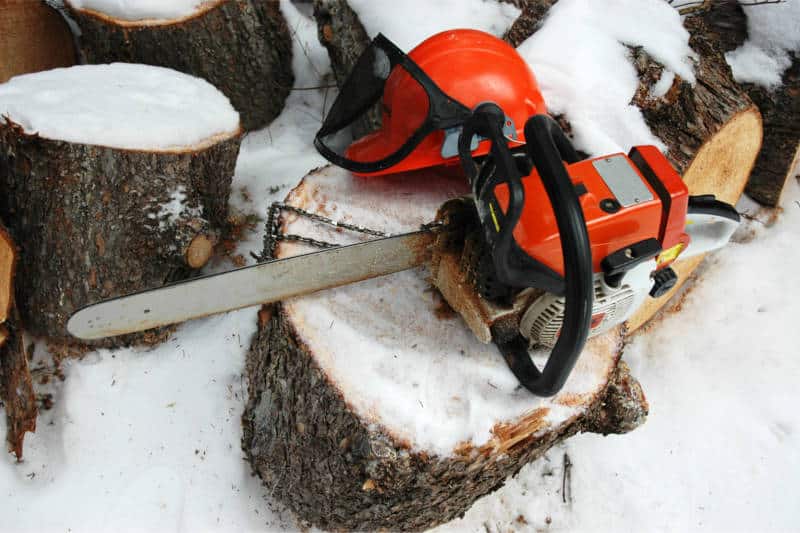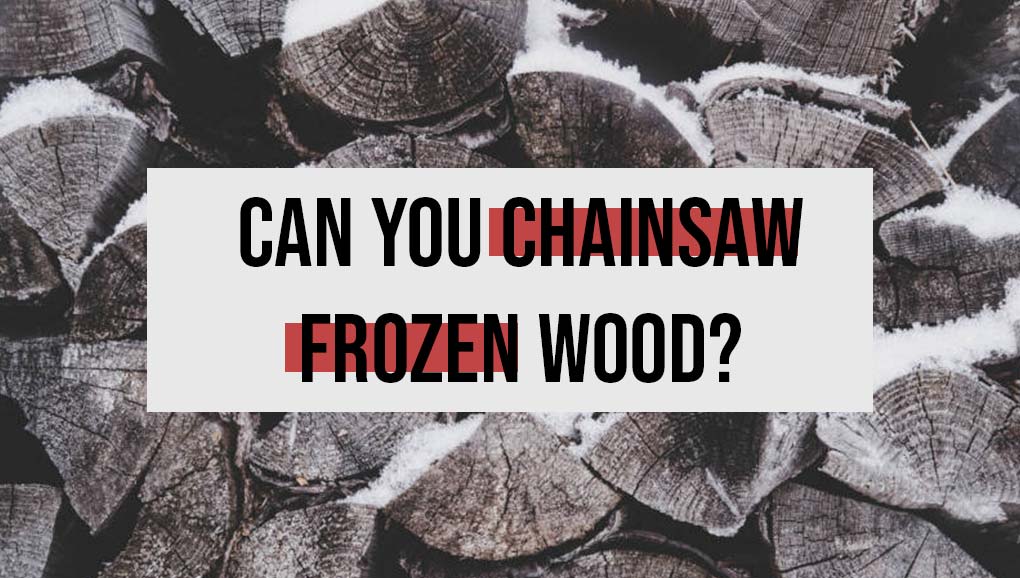Gardening Tips
Can you Chainsaw Frozen Wood?
When the weather starts to get colder, you may find yourself in a situation where you end up trying to cut frozen wood. Whether you’re trying to cut firewood for the winter months or complete a project at work, you might find yourself wondering, is it possible to chainsaw frozen wood?
It’s not impossible to cut frozen wood with a chainsaw, but it is extremely difficult. Cutting wood requires a sharp chain and frozen wood will dull your chain. You will have to perform additional maintenance on your chainsaw in the winter months and wear protective gear in order to successfully cut frozen wood.
You’ll have to wear protective gear
There are multiple reasons why you might find yourself trying to cut through frozen wood. If you live in an area that has freezing temperatures during the winter months, wearing protective gear is even more important. Certain safety hazards become more prevalent during the colder months.
For example, wood is more likely to splinter in freezing temperatures, so it’s important that you make sure you’re wearing your helmet and eye protection gear in order to avoid injury while you’re using your chainsaw. You can choose to wear chainsaw gloves, earmuffs, protective glasses, and a face mask like these while you work on your project. You also might want to consider purchasing snow resistant and cut resistant pants, in order to stay warm and protected from injuries.

You’ll have to perform additional maintenance to your chainsaw
You should be performing routine maintenance on your chainsaw throughout the year, but the cold weather presents unique challenges. If you own a chainsaw that has a winter shutter or a pre-heating system, make sure to switch these on. This will help to prevent your chainsaw’s engine from failing in the cold or snowy weather.
The most important maintenance tip is to keep the sprocket cover clean so that the snow and moisture that comes with the colder weather doesn’t build up. You’ll also want to make sure that you clean the chain groove, purchase a new spark plug, and clean your saw’s air filter before you get started on your project.
You’ll also want to purchase a winter-grade lubricant so that you can drain the chainsaw bar oil and replace it.
Try using a different chain
You can also try using a semi-chisel chain. Make sure to choose a rounded semi-chisel chain instead of a sharp-pointed chisel chain. The truth is, it doesn’t matter what chain you choose, the frozen wood that you are cutting will end up dulling the chain that you are using. If you do not want to try using either of these chains, you can try using a DuraCut chain. This type of chain is affordable and it stays sharp for three times longer than a regular chain. Another option is using a carbide-tip chain, which will have a much better chance of enduring the frozen wood you are trying to cut.
Keeping your chain sharp is the most important part
Before you even attempt to cut frozen wood, you should have sharpened your chain and made sure that you had spare chains just in case. Decreasing the filing angle when you’re sharpening your chain will help to reduce the vibrations and add less wear to your chainsaw.
Waiting for warmer weather is the best option
Cutting frozen wood with a chainsaw is possible, but it’s extremely difficult and requires many steps in order to ensure that you aren’t damaging your equipment or creating additional safety hazards for yourself. The truth is, the best and easiest method to cut frozen wood is to simply wait for warmer weather. If it’s possible to plan your project at a time where the weather will be warm enough to ensure that you won’t have to cut frozen wood, opt for this method. Obviously, this method is not always possible, but it is the simplest solution whenever possible.
Be cautious when you’re refuelling your chainsaw
During your project, you might have to refuel. If you have to refuel your saw while it is snowing outside, make sure that snow does not get into the fuel tank. This will cause your saw to sputter and eventually your saw may stop running altogether, depending on how much snow made its way into the tank. Make sure that you’re brushing away any snow or additional moisture that the cold weather brings from the fuel tank opening before you refuel. Letting snow and condensation sit on the opening can eventually rust and corrode your saw so that you will not be able to use it in the future.
Try re-designing your saw’s gullet
When you cut frozen wood, you’re not producing small chips of wood, like you would when working on projects in the warmer weather. Cutting frozen wood with a chainsaw produces a very fine powder that can get caught in other parts of the saw, leaving the gullet empty. The saw’s gullet is designed to be full while you are using your saw because the weight from the wood chips puts pressure on your saw, and allows it to continue cutting straight.
A solution to this is re-designing your saw’s gullet when you are using it to cut frozen wood. When you add an extra notch cut to your saw, this will help to contain that fine powder you’re left with after cutting frozen wood. This way, the saw powder won’t get stuck in other parts of your saw and you still have the extra weight that you need in order for your saw to continue running straight.
You can chainsaw frozen wood, but it can be difficult
It is possible to cut frozen wood with a chainsaw, but it poses many risks and challenges that you won’t run into when cutting wood that is not frozen. It’s easier to cause damage to your chainsaw, you pose greater safety risks to yourself, and it will be a much more time-consuming process. It is only recommended that you try doing this if you absolutely have to, and don’t have other options.
If you have managed to chainsaw your logs into workable dimensions, it may be time to invest in a log splitter. Why do you need a log splitter? Check out our log splitter guide to find out more.

